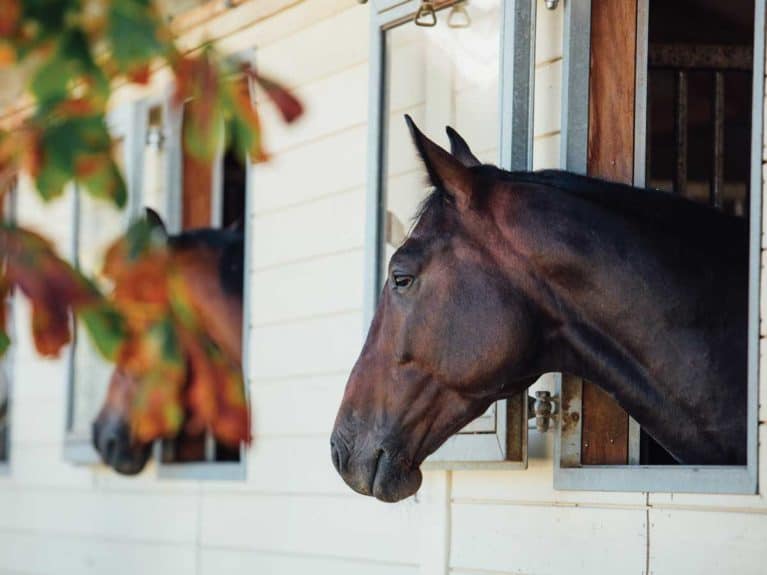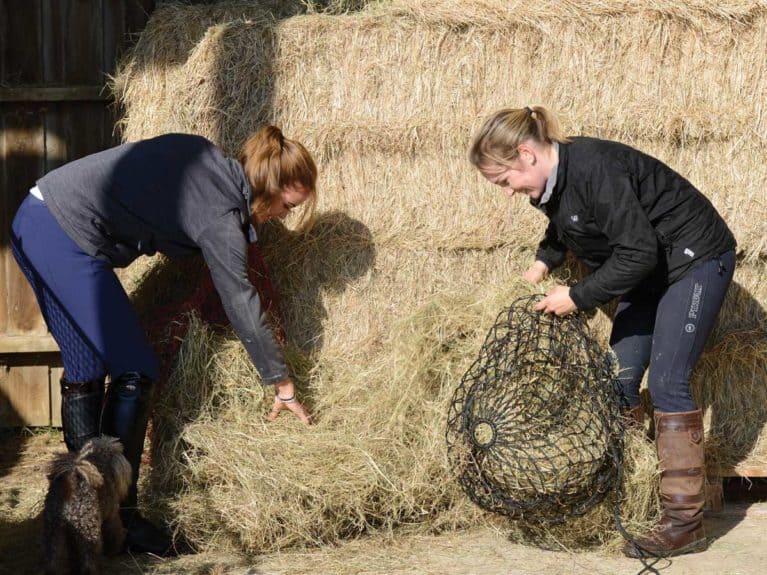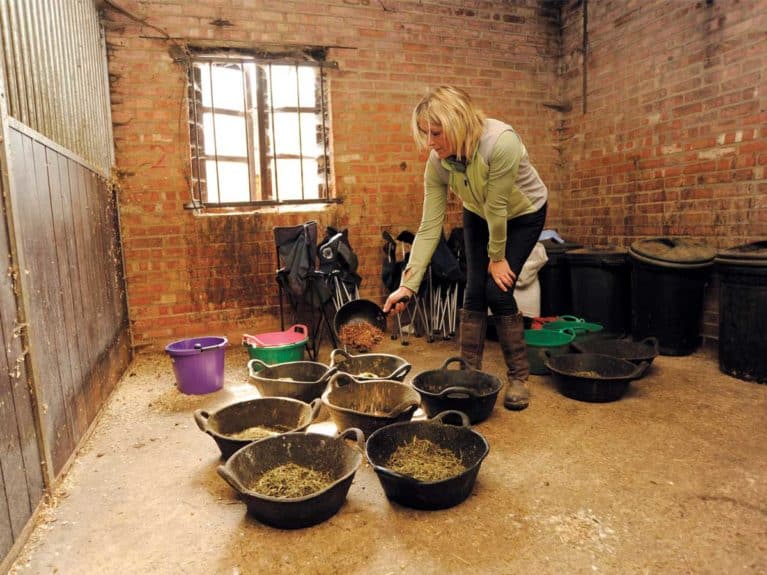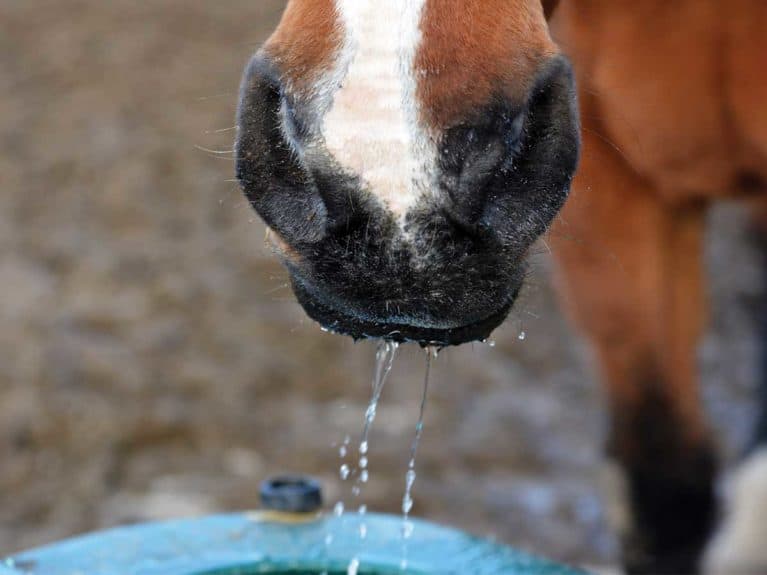Box rest can be challenging for horses and owners alike. Joanna Palmer, Nutritionist at Allen & Page, explains how to help your horse cope while continuing to meet his nutritional needs

While continuous, or at least regular, daily turnout is preferable for your horse’s health and wellbeing, sometimes an extended period of time in the stable is unavoidable. Whether he’s confined due to illness or injury, or as a result of poor weather or ground conditions, it’s vital to ensure his diet is adjusted accordingly to maintain digestive health and prevent excitability.
DID YOU KNOW? Because energy and calories are the same thing, feeding your horse a high-energy diet while he’s on box rest is likely to result in weight gain.
All change
When a working horse’s exercise and turnout is greatly reduced, an immediate reduction in the quantity of concentrate feed is often required. It’s usually recommended that dietary changes are made gradually over a period of at least 10 days to allow the beneficial bacteria in your horse’s gut to adjust. However, the risk of problems such as equine rhabdomyolysis syndrome (ERS, or tying up), colic and laminitis caused by excess energy can pose a greater risk to your horse’s health, often making a more hasty removal of high-energy food necessary.
Most horses on prolonged box rest or reduced turnout will benefit from changing to a lower calorie feed, which will help prevent excessive energy levels and excitable behaviour. The vast choice of feeds can feel overwhelming, but the most important thing to remember is to choose one that’s high in fibre and low in sugar and starch. This type of diet will not only help to avoid your horse having excess energy, but the high fibre and low starch levels are also more gentle on his digestive system because it’s closer to what he’d naturally eat.
TOP TIP – Choosing a feed that contains a prebiotic, or adding a prebiotic supplement to your horse’s diet, can help maintain a healthy digestive system, particularly during times of stress such as enforced box rest.
Fantastic forage
Your horse’s digestive system is designed for an almost continual supply of fibre, which is his most important source of nutrition, and is essential for keeping his digestive system healthy and functioning correctly. Ideally, stabled horses should have hay or haylage available at all times, as this will need to provide the entirety of his daily fibre requirement when grazing isn’t possible. Offering a variety of different fibre sources, such as hay, haylage and alfalfa, can help to mimic the variety of grasses that would be found in your horse’s natural diet and encourage a greater consumption of forage.

Spending a large proportion of time confined to a stable isn’t ideal for your horse, both physically and psychologically. Medical problems such as colic and gastric ulcers, and stable vices including weaving and crib-biting, can all occur more readily in stabled horses due to a combination of factors including stress, insufficient fibre intake and reduced mobility. Ensuring your horse has a continuous supply of forage available can significantly reduce the risk of these problems developing.
DID YOU KNOW? In the wild, horses graze for up to 18 hours a day.
Make it go further
For good-doers, an all-forage diet will often provide all the calories needed to maintain an ideal bodyweight, particularly if your horse isn’t using any energy up through exercise. However, feeding forage ad lib may provide too many calories and cause unwanted weight gain. If this is the case, soaking his hay for 12 hours will significantly reduce its calorie content, but still provide essential fibre.
Small-holed haynets or a hay feeder designed to slow down consumption are ideal for good-doers, meaning you can make a smaller forage ration last longer. It may be necessary to split your horse’s total daily ration into several meals and feed these throughout the day, with the largest portion fed as late as possible to avoid him going for a long period overnight without any fibre.
In balance
No matter how good your forage, it’s unlikely to provide all the vitamins and minerals that are particularly important at a time when your horse’s body may be repairing itself. Any deficiency can be overcome by feeding the recommended daily amount of a complete feed. For good-doers, it may be better to offer a token amount of feed and top it up with a broad-spectrum vitamin and mineral supplement or feed a pelleted balancer.

TOP TIP – The longer your horse spends chewing, the more saliva he’ll produce. This helps to buffer stomach acid and maintain a healthy digestive system.
Divide and conquer
One of the most important aspects of feeding a horse on box rest or reduced turnout is to mimic the continuous supply of fibre through the digestive system that he would get from grazing. Here are some ways you can encourage natural behaviour and make his meals last longer…
- splitting feeds into as many small meals as possible will help to relieve boredom
- dividing each meal into several buckets and placing them around the stable to encourage natural grazing behaviour
- discouraging him from taking large mouthfuls by putting an obstacle, such as a large, flat stone, in his feed bucket or spreading the feed out in a long trough
- adding chaff or chopped fibre to his feed provides an additional source of fibre, and helps to increase chewing and eating time
A little extra help
Horses who have a tendency to lose weight may be more likely to do so when on box rest. Alongside ad lib, good-quality forage, a suitable conditioning feed is one that’s high in fibre and low in starch and sugar, as this is more natural for your horse.
Feeds that contain a high proportion of cereals should be avoided, as these have a significantly higher starch content than those that use fibre and oil as energy sources. A high-starch diet can not only cause fizzy, excitable behaviour, but it’s also more difficult to digest and can make your horse more susceptible to developing laminitis or colic.
TOP TIP – Oil is very energy-dense compared to cereals and the energy it provides is slow-release. Gradually introducing it to your horse’s diet can help to increase calorie intake without risking excitable behaviour.
Stay hydrated
Your horse’s water needs will vary through the seasons and according to his level of work. On average, a resting horse requires five litres of water per 100kg of bodyweight, meaning the average 500kg horse on box rest will need at least 25 litres each day, which can be from drinking and through his diet. When you consider that grass can have a moisture content of up to 85%, while hay is just 15–20%, the overall water content of your horse’s diet will decrease significantly when he’s stabled, so it’s important that he has a clean, palatable source of drinking water available at all times.

Keep a close eye on how much your horse is drinking and, if necessary, try tempting him to drink by putting a small amount of apple juice in his water bucket. However, many horses can be reluctant to drink as much as they need to when on box rest, so offering a high-fibre feed that requires soaking is an excellent way to boost water intake. Feeding hay that’s been soaked or well-dampened will help to increase his total water intake, too.
TOP TIP – If your horse has an automatic waterer in his stable but you’re concerned he’s not drinking enough, try swapping to buckets while he’s confined to his stable.
DID YOU KNOW? Signs of dehydration can include dark-coloured urine and a bed that’s less wet than usual.















